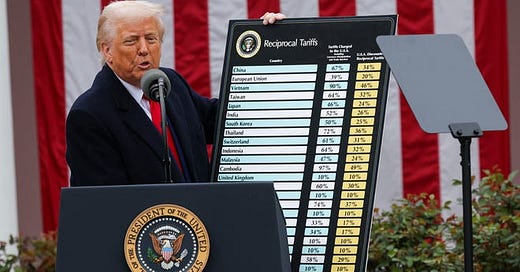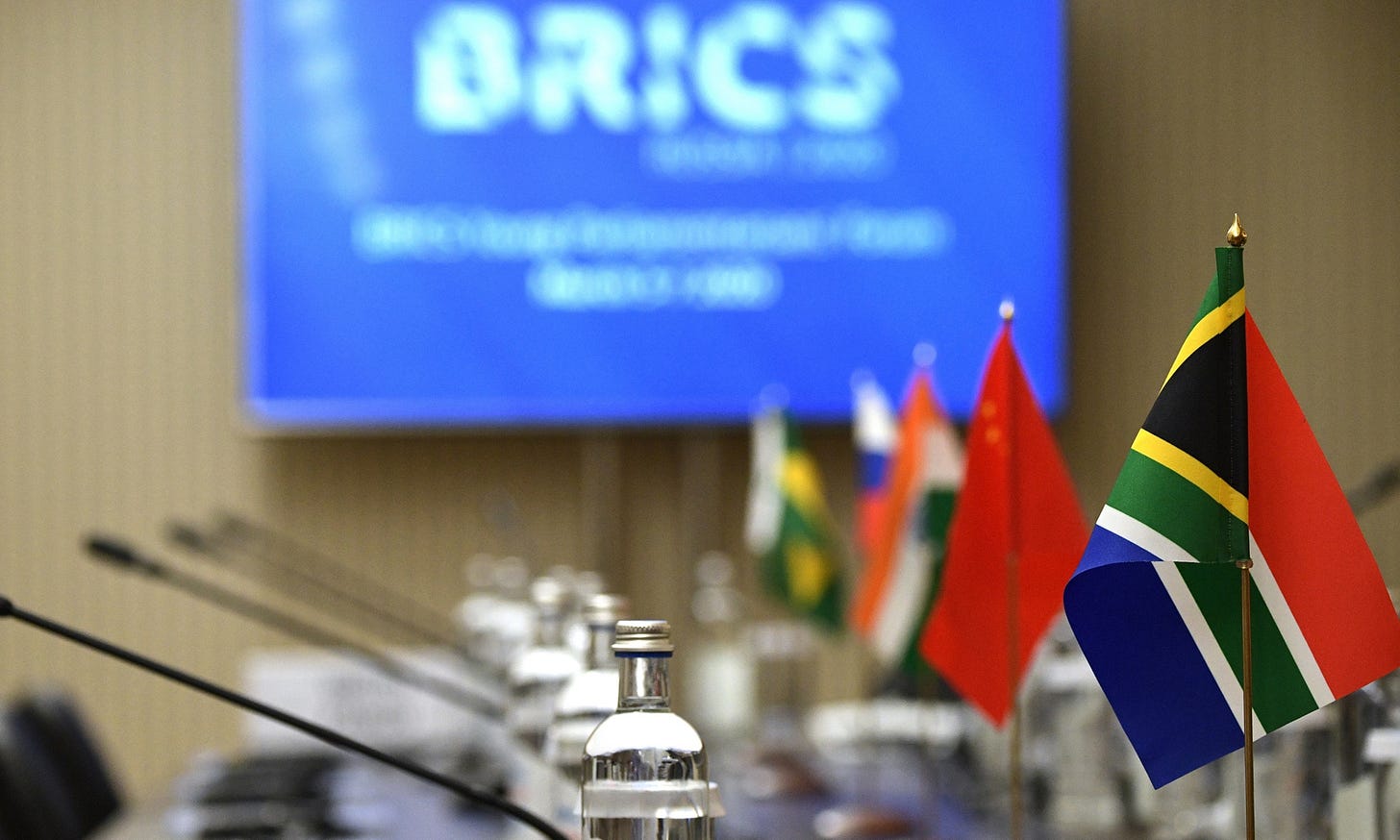The world has been gifted an invitation from the U.S. President Donald Trump to distance itself from the American political economy and accelerate its decoupling from the U.S. dollar dominated trade settlements and finance system. It’s not just an invitation; it’s effectively a demand. In announcing his administration’s so-called “reciprocal tariffs,” Trump has demonstrated the callow nature of its politics and its capricious arbitrariness. The U.S. is not a dependable economic partner; the more erratic its policy making gets, the less stable it is.
The U.S. is a one-trick pony, girded by a deep sense of indispensability mixed with a grievance of victimhood. This cocktail of calumny has self-harm written all over it, and blazes a warning to the rest of the world: steer clear. Efforts to force behavioural change in others, by way of punitive measures, is a not-too-subtle case of ‘beggar thy neighbour’ in which economic policy is viewed through the lens of zero-sum contest.
The current round of so-called reciprocal tariffs demonstrates a capricious and, indeed, mendacious approach to policy making that is deeply arbitrary. The calculation of the reciprocal tariffs were not in actuality based on any detailed analysis of other countries’ tariff and non-tariff barriers, however problematic that may itself be, but were a result of a simple excel-sheet calculation: divide America’s net trade position with the other country’s exports to the US and then divide that again by two.
A case in point is Lesotho.1 Lesotho is an African country with an annual GDP of $2.4 billion, making it one of the poorest countries in the world. As a member of the Southern African Customs Union, Lesotho applies the common external tariff established by the SACU. That is, the tariff Lesotho applies is the same as that which is applied by South Africa, Namibia, Eswatini and Botswana. If the calculation of the reciprocal tariff was based on the tariffs levied by the trading counterparty, then it follows that all SACU members would be hit with the same reciprocal tariff. In fact, this is not what has happened. Lesotho is levied a 50% tariff; Namibia 21%, South Africa 30%,Botswana 37% and Eswatini 10%. The reciprocal tariff calculation was derived by dividing the US trade balance with exports. Thus, in the case of Lesotho, it exports about $236 million each year, mainly consisting of diamonds, textiles and apparel, while it imports about $7 million. Such low levels of imports are a function of the fact that most Lesotho residents earn no more than $1,300 per year; American-made goods are simply out of their price range. For Lesotho, the calculation is $229m / $236m = 97%.
Indonesia is another case in point. The US runs a deficit of about $17.9 billion and exports $28 billion to the US. Thus, $17.9B / $28B = 64%.
The absence of consistency with the claim that the tariffs are about ‘reciprocity’ is evident in the fact that countries that run trade deficits with the US with zero tariffs have been hit with tariffs; Australia being the case in point, which has been levied a 10% tariff despite running a trade deficit with the US of some US$2.2 billion in 2024.
The Evidence of Ineffectiveness
Tariffs are the US President’s favourite word, but they are likely to create more self-harm than anything else. The track record of tariffs since 2018 has been clear; they did not ‘bring back the jobs’ and rejuvenate American manufacturing. Imports did not abate, and America’s trade deficit widened. Economically, they did not deliver on the promise. Politically, they energise the disaffected, but that is all.
There is mounting evidence from Trump’s first term and its legacy about the efficacy of tariffs insofar as their stated aims are concerned. The evidence leans heavily towards demonstrating that tariffs were at best neutral in effect, or worse, counterproductive. Snake oil, anyone?
In a 2024 paper, David Autor and his co-authors explored the economic and political consequences of the 2018-2019 trade war between the United States, China and other US trade partners at the detailed geographic level. The salutary conclusion is that so far, “the trade-war has not provided economic help to the US heartland.” Author and co observe that, “import tariffs on foreign goods neither raised nor lowered US employment in newly-protected sectors; retaliatory tariffs had clear negative employment impacts, primarily in agriculture; and these harms were only partly mitigated by compensatory US agricultural subsidies.” The net effect economically speaking was negative. This finding reinforces the growing body of empirical evidence that concludes that Trump Tariffs 1.0 have led to net negative results on American welfare.
In a 2019 paper for the Federal Reserve Board, Aaron Flaaen and Justin Pierce concluded that any small positive employment effect of direct import protection was undermined by larger negative effects from rising input costs and retaliatory tariffs. The employment effects in the US are net negative. They conclude that “U.S. manufacturing industries more exposed to tariff increases experience relative reductions in employment as a positive effect from import protection is offset by larger negative effects from rising input costs and retaliatory tariffs. Higher tariffs are also associated with relative increases in producer prices via rising input costs.” Flaaen and Pierce’s work goes to the heart of the flow-on effects of tariffs, which may contribute to employment gains in the directly protected industries but ultimately lead to net job losses as higher costs filter through into downstream sectors.
Javorcik and co-authors in a 2022 paper for the World Bank Group analysed the impact of the 2018 tariffs on employment by way of analysing job offers. They found that tariffs on imported inputs and retaliatory tariffs resulted in “a relative decline in online job postings in affected commuting zones.” Conversely, they found no evidence of positive impacts of import protection on job openings, concluding that “the tariffs led to a combined effect of 175,000 fewer job postings in 2018, or 0.6 percent of the US total, with two thirds of this aggregate decline due to the imported input tariffs and one third due to retaliatory tariffs.”
Between 2018 and 2023, according to data from the St Louis Fed, the U.S. manufacturing sector saw an increase of approximately 200,000 jobs, growing from about 12.7 million to 12.9 million employees. However, during the same period, total non-farm employment in the U.S. increased from approximately 149 million in 2018 to 156 million in 2023, reflecting a growth of about 7 million jobs. This indicates that while manufacturing employment grew by roughly 1.6%, total employment expanded by about 4.7% over the five-year span, suggesting that manufacturing employment growth lagged behind overall employment growth. Tariffs imposed since 2018 did not prima facie lead to a resurgence in manufacturing employment.
American manufacturing has seen output growth expand between 2018 and 2023, however. According to Statista, manufacturing output, as measured by real value-added, increased from $2.2 trillion in 2018 to $2.8 trillion in 2023, marking a growth of approximately 27%. Over the same period, the U.S. GDP grew from about $20.5 trillion in 2018 to $25.5 trillion in 2023, indicating an overall economic growth of approximately 24%, suggesting that manufacturing output growth marginally exceeded that of the economy as a whole. This disparity suggests productivity improvements within the manufacturing sector, as output increased more substantially than employment, again suggestive that if one of the main goals of tariffs is to rejuvenate manufacturing employment, then the results so far are less than encouraging.
Lastly, we can consider American manufacturing’s net trade position. Recall that one of the main concerns is the net trade deficit in manufactures. Between 2018 and 2023, U.S. exports of manufactured goods saw an overall increase. In 2021, manufacturers exported $1.4 trillion in goods, accounting for a significant portion of total U.S. exports. By 2024, total U.S. exports of goods and services reached $3.2 trillion, up from $3.1 trillion in 2023. Despite the increase in exports, however, the U.S. continued to run a trade deficit in manufactured goods. In 2024, the overall goods and services deficit was $918.4 billion, an increase of $133.5 billion from 2023, according to data from the U.S. Census Bureau and the U.S. Bureau of Economic Analysis. This widening deficit suggests that imports of manufactured goods outpaced exports, leading to a negative net trade position for the sector. Again, despite the introduction of tariffs, the net deficit in manufactured trade continued to widen.
The Absence of Leverage
The United States is pursuing policies that in 2025 has far less leverage than they may have had a decade or two ago. This is for the basic reason that the contours of global trade have fundamentally changed over the course of the last two decades. The US contributes less than 15% to global trade today, half of what it did at the beginning of the century. This has taken place as China has evolved to become the largest trading partner of over 150 nations, and where trade volumes amongst the rest of the world (not the US) has grown faster than trade involving the US. This pattern or trend is unlikely to diminish. IMF and others have consistently forecast that the global south will experience rates of growth exceeding that of the G7. Trade growth amongst the global south (south-south collaboration) is also growing at above average growth rates, which means the US’ role in global trade will continue to diminish in relative terms.
It is often said that the tariffs will have an outsized effect on China, and that in fact, the tariffs war launched by Trump 1.0 and continued ever since - whether it was by Biden, or extended under Trump 2.0 - was always targeted at China. China is, as far as the US is concerned, its only economic and political adversary. This assessment was recently confirmed by a Department of Defence memo, reported on by the Washington Post, in which China was designated as the “pacing threat”. All efforts since Obama’s ‘pivot to Asia’ have had China in their sights, and Washington’s frustration in recent years is that it has been distracted by commitments elsewhere in the world; I talk of Ukraine in particular, from which Washington is keen to wash its hands and pass the baton of Russia containment to the Europeans.
So let’s put China’s trade relations with the US into some context of magnitudes. In 2024, the United States reported a goods trade deficit with China of approximately $295.4 billion, indicating that U.S. imports from China exceeded exports by this amount. This comprised American exports of $143.5 billion and imports from China of about $438.9 billion. Incidentally, for the reciprocal tariffs calculation, the result is $295.4 / $438.9 = 67%. The reciprocal tariff imposed on China as announced is 34%. Yet, the surplus China has with the US represents less than 5% of its total trade volume in 2024. Put plainly, the US market is not as important as it once was.
Now, let’s put the surplus with the US into per capita terms. For 2024, China’s population was estimated to be around 1.408 billion people. This means the trade surplus with the U.S. is in the order of $209.80 per person. In 2024, China’s GDP per capita, adjusted for purchasing power parity (PPP), was estimated to be approximately $19,436 international dollars. China’s trade surplus with the U.S. is equivalent to 1.08% of GDP per capita. The implication of this is that adjustment magnitudes aren’t particularly big, which in large part is what the fiscal and monetary policy measures announced at the ‘two sessions’ in March 2025 are designed to address. Of course, it goes without saying that in aggregate the adjustment magnitudes are readily manageable, but it should be noted that the mechanics will be invariably a little uneven as different sectors and enterprises are impacted differently. But these are manageable through nimble policy execution.
Transitions are Possible
At a global level, estimates by Professor Simon Evenett suggest that nations across the world could fully compensate for loss of the US market within 4 years. Some nations will do so quicker than others, due to differences in their economic structures and trade exposures to the United States market. For Evenett, these estimates are based principally on the compensating effects of the organic growth in trade that each country enjoys with others, other than with the United States. I have previously argued that in addition to organic growth, with fiscal measures and conscious coordination of policy responses, including via enhancing bilateral and multilateral trade institutions, it is conceivable that full compensation can be achieved for most countries in even less time than Evenett estimates.
Because the US is playing an ever-diminishing role in global trade, and because nations can achieve managed adjustments within a not unreasonable period of time, the Americans really don’t - to borrow a phrase that President Trump has popularised - have many cards at all.
The principal counter argument to this is that only America’s capital markets have sufficient scale and depth to finance the global trade deficit, and particularly the deficit with China. Firstly, it's worth noting that in 2023, China’s trade surplus was approximately $593.9 billion; the total value of international trade was estimated to be around $31 trillion. This means that China’s total trade surplus is about 1.92% of the total value of world trade. For those who speak alarmingly about China’s surpluses, once placed into a global context, it is clear that the alarm is not warranted.
Secondly, the claim is that China’s surplus (or the world’s deficit) is largely financed by American capital markets. This gets ‘cause and effect’ around the wrong way. For the US’ part, its trade deficit is financed by dollars that are created through either government spending or commercial bank credit. These mechanisms create money ex nihilo. In other words, the payment for imports is not financed by the capital markets at all. Rather, the capital markets absorb the dollars as a result of the dollars being spent. In other words, the ability of the world to trade with China and compensate for the loss of the US market is not constrained by US capital markets.
Financing global trade and enabling settlement can be done with currencies other than the US dollar. This has been happening increasingly over the past decade, and the pace of transition to currency multipolarity has been picking up in this period due in large part to the weaponisation of the US dollar and associated institutions. The experience of Russia since 2014 is the best illustration of the ability for entire economies to transition away from the US dollar as trade settlement means of payment, while at the same time expanding trade. Over 50% of China’s trade is now settled in RMB. The development of BRICS Clear will only contribute to this.
Conclusion
The reciprocal tariffs imposed by the Trump administration will be disruptive. Such large scale structural changes to global relative prices invariably result in system shocks. But, this should be viewed as a blessing in disguise.
The rest of the world can readily absorb the impacts, particularly through concerted efforts to strengthen multilateral and bilateral trading relationships and institutions, coupled with fiscal policy responses at a national and trans-national level. The adjustment period will be relatively short-lived (a few years at most), with the benefit of emerging into a post-US dollar dominated global trading system. The design and imposition of the reciprocal tariffs also demonstrates the capriciousness of American policy makers. The tariffs aren’t based on any rational evaluation of tariffs and non-tariff barriers (however debatable that may be). Rather, they are a simple calculation of the deficit / that country’s exports. In many cases, this was then halved to create a sense of benevolent discounting. This is policy-making ‘on the run’.
The United States clearly sees itself as a victim; of being hard down by, taken advantage of, by the rest of the World. That’s its prerogative. However, given the outsized dominance of the US dollar, the influence of the US over the decades on multilateral institutions, the lead role the US has played in imposing sanctions on dozens of countries around the world, the longstanding though declining preponderance of the US military globally and the fact that the US has initiated over 210 military interventions in other countries since 1946 (Duffy Toft and Kushi, 2023 Dying by the Sword), it is hard for much of the world to agree with the American’s sense of grievance. You can’t claim to be the ‘most exceptional' nation to have ever occupied the world and credibly assert victimhood.
Liberation Day is an invitation to self-liberate from a global political economic system that has hampered the ability of countries to pursue effectively their own sovereign development pathways. The world can see the US for what it has always been, as the facade of liberal benevolence gives way to capricious narcissism. A multipolar world can be forged, as it is already emerging. When America is good and ready to join the world of nations, as a normal and equal partner, there will be a seat.
Thank you, President Trump. Invitation accepted.
I owe Arnaud Bertrand from a X post today for the Lesotho case discussed here.







